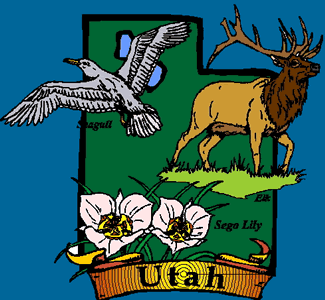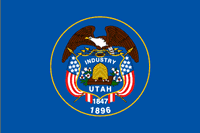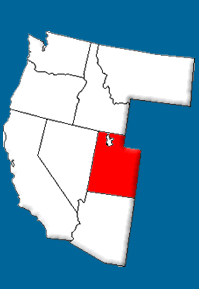 History:
The first Europeans to enter what is now the state of Utah were Mexicans and Spaniards. In 1540, Garcia Lopez de Cardenas may have entered southern Utah and in 1765, Juan Maria Antonia Rivera may have led at least two expeditions into the area. It is most commonly believed, however, that the region was first explored in 1776 by Spanish Franciscan friars Silvestre Velez de Escalante and Francisco Atanasio Dominguez. They were looking for a route between Santa Fe and Monterey, California. During their travels, they visited with the Ute Indians, but early snow storms forced them to return to Santa Fe before completing their trip. Before they left the area, they made detailed maps, and they drew pictures of plant and animal life, geography, and the appearance of the Ute and Paiute Indians. In 1819, a treaty between the United States and Spain recognized Utah as a Spanish possession. Utah remained under Spanish control until after the Mexican American War in 1848.
During the 1820s, traders continued to establish new routes to California, and a trading relationship developed between Santa Fe and the Indians in Utah. In 1824, American frontiersman Jim Bridger discovered the Great Salt Lake. Jedediah Smith made several journeys into Utah during the 1820s, and Miles Goodyear established Fort Buenaventura on the Ogden River in 1844. The Canadian fur trader Peter Skene Ogden led four expeditions into the Snake River area. These early expeditions were primarily focused on developing the lucrative fur trade, but by the 1830s, the fur trade was dying out, and it would be another 10 or 15 years before a second wave of pioneers would come to Utah.
In the 1840s, pioneers from the east began to undertake long journeys westward toward California. In 1841, the Bidwell party left the Oregon Trail and set off across the Great Salt Lake Desert. In 1846, the ill-fated Donner party was in search of a short cut to California through Utah, and met tragedy when their journey took too long and left them stranded in freezing temperatures. This group, a portion of which survived through cannibalism, assisted in showing pioneers new ways to the west.
The most important group to travel to Utah, however, was the Latter-Day Saints, or the Mormons. This group, fleeing religious persecution in the East and the Midwest, was led into the area by Brigham Young in 1847. They established Salt Lake City, and streams of other Mormons soon followed from the United States, Britain and the Scandinavian countries. In 1850, Brigham Young was appointed governor of Utah Territory by the United States. The Mormons originally wanted to name the territory Deseret (which means honeybee), but gave up that idea. To this day, however, the beehive remains a symbol of Mormonism in Utah. Soon, other Mormon settlements were established and by 1850, families were living in Bountiful, Farmington, Ogden, Provo and Manti. Each village was run by a leader selected by the church authorities, and the daily life of the people was dictated by their religious beliefs.
The Mormons wanted Utah to be admitted to the United States as a Mormon-led state. However, the Mormon Church permitted polygamy, or the ability of a man to have more than one wife, and the federal government refused to recognize Utah as a state because of this. At the same time, settlers in the area were encroaching on the land of the Native Americans in the area, and this conflict resulted in the Walker War of 1853 and the Black Hawk War of 1865--1868.
By 1857, the federal government declared that Utah was in a "state of substantial rebellion," and Brigham Young was removed from his post as governor. President James Buchanan directed US troops to act against Mormons if necessary. Church property was seized and polygamists were arrested. This conflict, called the "Utah War" or the "Mormon campaign" was settled peacefully, but the issue of polygamy continued to cause friction between Mormons and the federal government. Finally, in 1890, Mormon leaders issued a statement advising members to abstain from polygamy and by 1896, Utah was admitted to the Union as the 45th state. |









